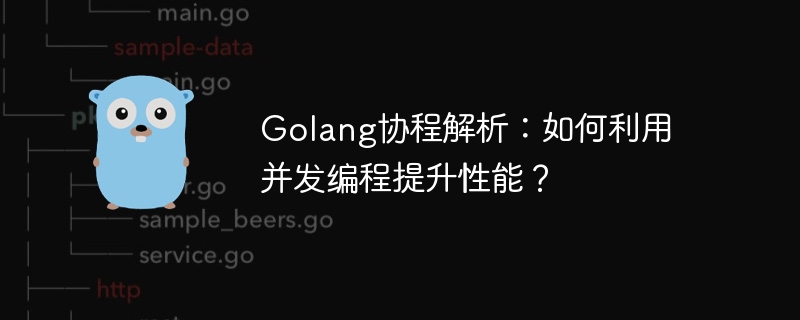Home >Backend Development >Golang >Golang coroutine analysis: How to use concurrent programming to improve performance?
Golang coroutine analysis: How to use concurrent programming to improve performance?
- WBOYWBOYWBOYWBOYWBOYWBOYWBOYWBOYWBOYWBOYWBOYWBOYWBOriginal
- 2024-02-29 09:33:03672browse

In today's software development field, performance optimization has always been one of the focuses of developers. As hardware performance continues to improve, software performance optimization is becoming more and more important. In concurrent programming, Golang provides a powerful mechanism to achieve concurrent performance optimization, which is the use of goroutines. This article will delve into how to use Golang coroutines to improve performance and analyze it through specific code examples.
What is a goroutine?
Coroutine (goroutine) is a lightweight thread mechanism used to achieve concurrency in Golang. Compared with traditional operating system threads, the creation and destruction of coroutines requires less resource overhead, allowing programs to perform concurrent tasks more efficiently. Coroutines are scheduled by the runtime of the Go language, and developers do not need to care about thread management and scheduling.
In Golang, you can create a coroutine through the keyword go. The following is a simple example:
package main
import (
"fmt"
"time"
)
func main() {
go hello() // 创建一个协程执行 hello 函数
time.Sleep(time.Second) // 主线程休眠 1 秒,以等待协程执行完毕
}
func hello() {
fmt.Println("Hello, goroutine!")
}In the above code, the hello function is wrapped in a coroutine and started by go hello() Procedure. The main thread waits for the coroutine to complete execution because of the existence of time.Sleep(time.Second). In practical applications, coroutines can be used to handle concurrent tasks and improve program performance.
Methods to use coroutines to improve performance
- Concurrency execution of tasks
One obvious advantage is that through coroutines Execute multiple tasks concurrently to improve the processing capabilities of the program. For example, when a program needs to handle multiple network requests at the same time, it can use coroutines to process these requests concurrently instead of serially, thereby speeding up the overall processing.
package main
import (
"fmt"
"time"
)
func main() {
start := time.Now()
for i := 0; i < 10; i++ {
go process(i)
}
time.Sleep(time.Second) // 主线程休眠 1 秒,以等待所有协程执行完毕
elapsed := time.Since(start)
fmt.Printf("All goroutines took %s
", elapsed)
}
func process(i int) {
fmt.Printf("Processing job %d...
", i)
time.Sleep(time.Second)
}In the above code, we created 10 coroutines to execute the process function concurrently. Each function simulates the processing of a task. By observing the output, you can see that these tasks are executed concurrently rather than sequentially.
- Use channels for inter-coroutine communication
Communication between coroutines is an important way to achieve collaborative work of coroutines . Golang provides channels as a communication bridge between coroutines, through which data transmission and synchronization can be achieved. For example, channels can be used to control the execution order and collaboration of coroutines.
package main
import (
"fmt"
"time"
)
func main() {
ch := make(chan int)
go worker(ch)
go manager(ch)
time.Sleep(time.Second) // 主线程休眠 1 秒,以等待协程执行完毕
}
func worker(ch chan int) {
for i := 0; i < 5; i++ {
ch <- i // 发送数据到通道
time.Sleep(time.Second)
}
}
func manager(ch chan int) {
for i := 0; i < 5; i++ {
data := <-ch // 从通道接收数据
fmt.Printf("Received data: %d
", data)
}
}In the above example, the worker function sends data to channel ch, while the manager function sends data from channel ch Receive data. Through communication between coroutines, collaborative work of tasks can be achieved.
- Coroutine Pool
#In order to avoid the overhead caused by frequently creating and destroying coroutines, you can use the coroutine pool for reuse. Coroutines. By maintaining a fixed number of coroutine pools, when a task needs to be executed, a coroutine is taken out of the pool for execution and returned to the coroutine pool after execution.
package main
import (
"fmt"
"sync"
)
func main() {
poolSize := 3
jobCount := 5
pool := make(chan struct{}, poolSize)
var wg sync.WaitGroup
for i := 0; i < jobCount; i++ {
wg.Add(1)
pool <- struct{}{}
go func(i int) {
defer func() {
<-pool
wg.Done()
}()
fmt.Printf("Job %d processed
", i)
}(i)
}
wg.Wait()
}In the above example, we defined a coroutine pool of size 3 pool and created 5 tasks to be executed. Each time a task is executed, a coroutine is first taken out from the coroutine pool, and then returned after the execution is completed, thus realizing the reuse of the coroutine.
Summary
This article introduces how to improve the performance of the program through Golang's coroutines, and analyzes it in detail through specific code examples. Using coroutines to execute tasks concurrently, using channels to communicate between coroutines, and implementing coroutine pools are all effective ways to improve performance. In actual development, developers can flexibly use coroutines according to specific scenarios to improve the concurrent processing capabilities of the program and achieve high-performance concurrent programming.
The above is the detailed content of Golang coroutine analysis: How to use concurrent programming to improve performance?. For more information, please follow other related articles on the PHP Chinese website!

